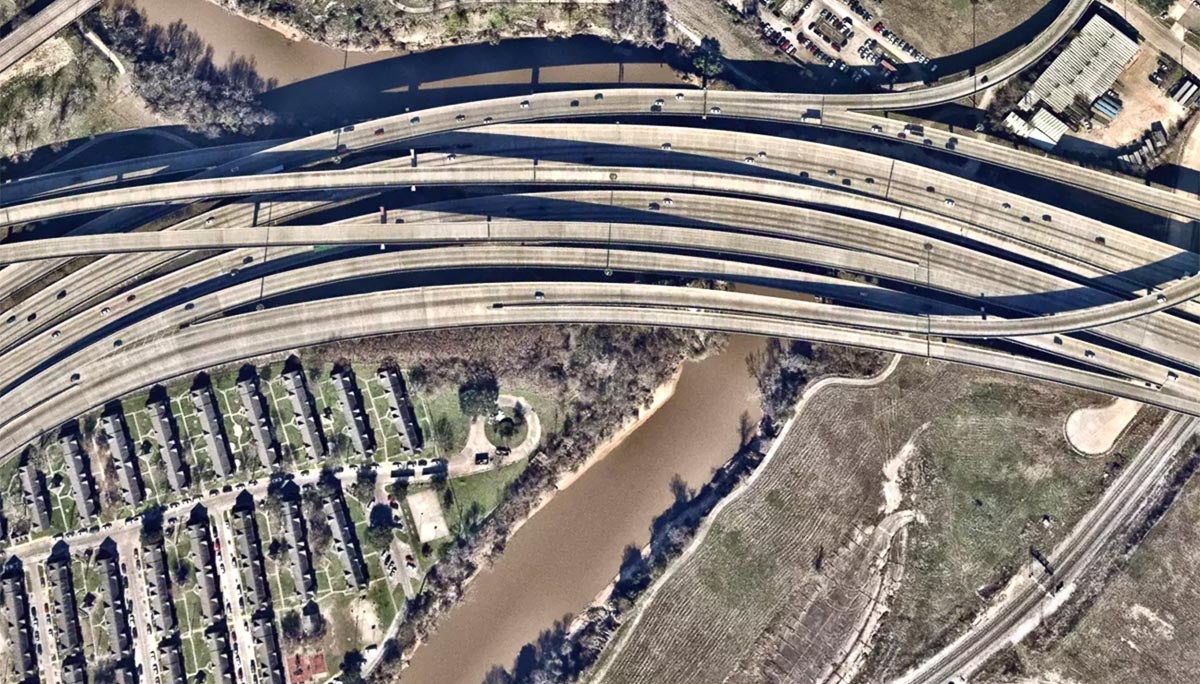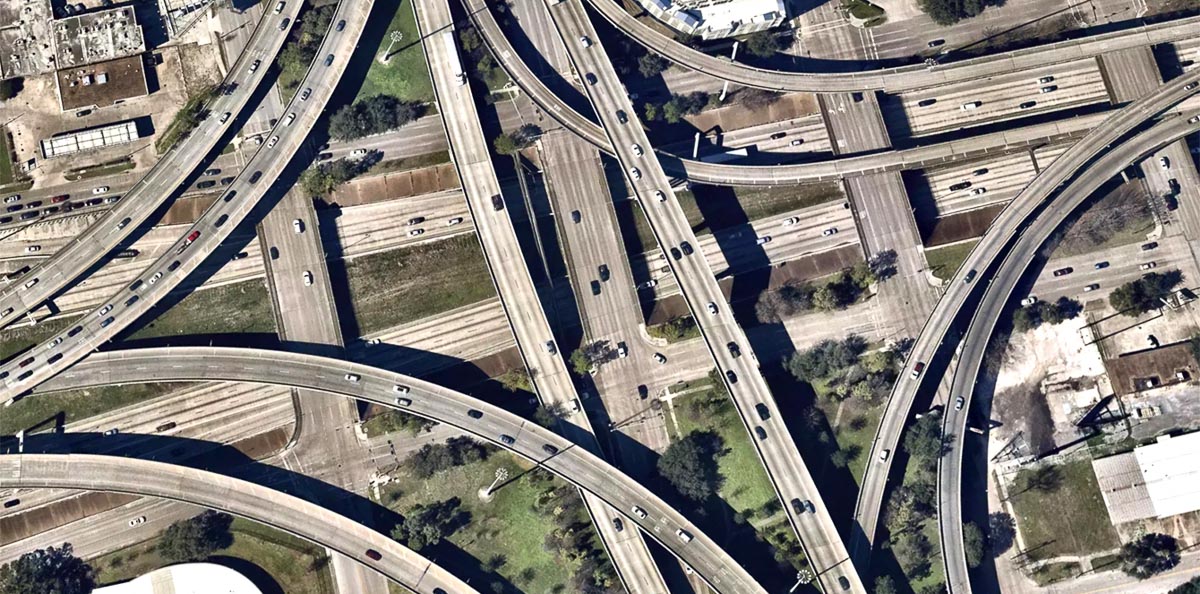Streetlight Data released its inaugural U.S. Transportation Climate Impact Index last week and big, sprawling cities like Houston, Dallas and most other Sunbelt Cities didn’t stack up well. Among Sunbelt Cities, Los Angeles and Orlando ranked highest (best), at Nos. 34 and 45, respectively. Houston (98), Phoenix (99) and Dallas (100) were at the bottom of the list, which ranked cities on six factors: vehicle miles traveled (VMT), biking and walking, transit ridership, density and circuity.
Sprawling cities weren’t helped by the fact that vehicle miles traveled carried the most weight of the factors used to determine rank.
“We made it so that an area could have no transit and do well because transit usage is not what drives carbon emissions, driving is what drives carbon emissions,” Streetlight Data CEO Laura Schewel told Fast Company. “So, if you manage to have a city where people on average are driving a lot fewer miles per capita to get what they need done, that’s just as good as having a city where a small portion of the people are taking transit.”
Transportation is the number one cause of carbon emissions in the United States. As a nation, we emitted 1.9 billion metric tons of it from cars, trucks, planes, trains, buses and boats in 2018. Transportation overtook power-plant emissions in 2016 as the top cause of carbon output, due in large part to an increase in the use of natural gas — while reducing the use of coal — to produce electricity.
Texas is No. 1 in emissions
Overall, Texas leads the nation in carbon emissions. The state produced 212 million metric tons from power plants and 232 million metric tons from transportation in 2017. Since 1990, transportation-related CO2 emissions have increased by 52%. In that same time, emissions from power plants have gone up by 17%.
Greenhouse gas (GHG) emissions — including methane, nitrous oxide, and carbon dioxide — from transportation have increased by 127% in the Houston metropolitan area in the past 30 years, and the amount of emissions per person has gone up 22%. Those increases were 133% total and 27% per person in the Dallas-Fort Worth area; 178% total and 12% per person in Austin; and 144% total and 39% per person in the San Antonio metro area.
Houston produced 16 metric tons of transportation-related carbon, according to C40 Cities, a worldwide network of “megacities committed to addressing climate change.” That total, which is based on 2014 data, represents 48% of the city’s GHG emissions. Houston is one of America’s 12 C40 city members.
The city’s 16 metric tons of carbon emissions was more than the transportation-related emissions of 16 states that year: Alaska, Connecticut, Delaware, Hawaii, Idaho, Maine, Montana, Nebraska, Nevada, New Hampshire, New Mexico, Rhode Island, South Dakota, Vermont, West Virginia and Wyoming. And Houston’s carbon output was four times greater than that of Delaware, Rhode Island and Vermont.

Houston has made commitments to carbon neutrality
It’s not that Houston and its leaders aren’t trying to make improvements and progress necessary for a more sustainable future. As a C40 city, Houston has committed to reaching peak emissions in 2020 and cutting greenhouse gases in the years going forward with a 2050 goal of carbon neutrality. To reach achieve that, the city and its partners have created a Climate Action Plan to:
► Decrease traffic congestion
► Improve air quality
► Provide better access to green space
► Improve quality of life
► Reduce costs through energy efficiency and renewable energy
At the C40 World Mayors Summit in Copenhagen last October, 35 mayors, including Houston Mayor Sylvester Turner, signed the C40 Clean Air Cities Declaration, pledging to make the air cleaner for the more than 140 million people living in their cities by. In signing the declaration, Turner and other mayors recognize “breathing clean air is a human right and commit to work together to form an unparalleled global coalition for clean air.”
The pledge is a commitment by the cities to establish “ambitious pollution reduction targets and implement substantive clean air policies by 2025. By publicly reporting on their progress, the cities plan to generate a ‘race to the top’ in cleaning the air in the world’s big cities.”
That same month, Turner announced the EVolve Houston partnership, which brings business, government and community leaders together with the goal of making electric vehicle sales 30% of new car sales in the city by 2030.
Are we willing to do what it takes to solve our problems?
It’s well documented that traffic congestion is a big concern for residents in the Houston region and for most people living in any mid-size or large metropolitan area. But in many American cities, there seems to be a certain degree of disconnect between initiatives to reduce congestion and pollution, and increase safety for those who choose active transportation — that is, those who bike, walk or roll — and projects that build new freeways and increase parking.
These disconnects are made apparent in the Menino Survey of Mayors from Boston University’s Initiative on Cities. Released earlier this week, the survey shows that a majority of mayors who participated — 76% — agree U.S. cities are too reliant on cars and 66% recognize vehicles as the biggest source of GHG emissions, but at the same time they don’t seem to support changes in real life, such as paid parking and reduced speed limits, that could affect congestion and safety on city streets.
Regarding safety for bicyclists and pedestrians, almost 50% of mayors expressed concern about the safety of cyclists and persons with disabilities who used city streets. And when asked what policy and design changes have had the greatest impact on pedestrian safety in their cities, they cited a wide variety, including sidewalks, traffic calming, signalization, Complete Streets, curb cuts, crosswalks, lighting, Vision Zero and more.
Yet two-thirds of mayors named roads among their top three infrastructure priorities while just 22% said “bicycle friendlessness” was a priority. And 77% said speed limits in their cities were at the right level.

5 steps to getting better
Perhaps many cities, Houston among them, are “trying to have their cake and eat it, too,” which is step 3 on city planner and urbanist Brent Toderian’s “5 steps to making better cities.” Of step 3 cities, Toderian writes:
Cities in this step have started to invest in better things, like transit and biking infrastructure, and putting in place the right policies, like smarter decisions on land use. But at the same time they continue to do the wrong things, and usually bigger. A favorite example is Denver’s decision to build a new light rail line, while at the same time widening the highway beside it and requiring massive parking structures at LRT stations. How about Brisbane, Australia, investing in bus rapid transit and a bike-lane “freeway” under their elevated waterfront expressway (which they really should tear down), while still spending most of their transportation money trying to make it easier to drive. Cities stuck in this step are often frustrated that they’re not seeing actual progress–like mode shift from driving to transit ridership. But that really isn’t surprising, since they won’t make the hard choices that lead to the kind of city they describe in their visions and plans.
Since Mayor Turner took office, there have been a number of promising commitments to reduce Houston’s carbon footprint in the face of climate change and its frightening consequences as well plans to improve safety for all on the roadways.
“We need a paradigm shift in order to achieve the kind of mobility outcomes we desire,” Turner told the Texas Transportation Commission in 2016.
Many who supported Turner’s call for Texas to stop trying to fix transportation problems by adding more roadway capacity are now scratching their heads over his endorsement of the North Houston Highway Improvement Project (NHHIP). Transit advocates see this and other highway projects as outdated and futile. To them, the NHHIP is a classic step 3 move by a city that has begun “to invest in better things, like transit and biking infrastructure, and putting in place the right policies, like smarter decisions on land use. But at the same time they continue to do the wrong things, and usually bigger.”
Turner laid out his reasons for why the I-45 is good for the city and its residents in an Urban Edge post in June. His post was part of a series examining a number of perspectives on the project. Turner wrote:
At its core, this project is about easing congestion as Houstonians travel through and around Houston. Wherever you look, it’s clear we are growing. How will we accommodate this growth? The Average Daily Traffic (ADT) volumes of I-45 are projected to increase along this already heavily traveled corridor by as much as 30 percent between now and the year 2040.
The road must accommodate this traffic but, instead of simply adding more concrete, the project moves us forward in a multi-modal way.
Residents can still provide feedback on improvements
Though he supports the plan, Turner acknowledges it isn’t perfect — no $7 billion project is. There are concerns about the expansion’s impact on mobility, safety and health in neighborhoods affected by the project.
The I-45 project will take close to 10 years to complete and Turner calls on Houstonians to remain engaged throughout the process and to attend community workshops where they can offer input and feedback. According to the city, it has already begun developing concepts to improve and change the NHHIPP based on input from the community.
There are three more workshops coming up in the next couple of weeks:
► Thursday, Jan. 30, 6 p.m.–8 p.m., Emancipation Community Center, 3018 Emancipation, 77004
► Saturday, Feb. 1, 10 a.m. – noon, Aldine Ninth Grade School, 10650 North Fwy., 77037
► Monday, Feb. 3, 6 p.m. – 8 p.m., Harris County Department of Education, 6300 Irvington, 77022
In addition to the city’s community engagement workshops, residents can also offer comment on Jan. 27 at a panel discussion with City Councilmember Dr. Letitia Plummer and at the Jan. 28 city council meeting:
► Monday, Jan. 27, 6 p.m. – 8:30 p.m., I-45 panel discussion with City Councilmember Dr. Letitia Plummer, Emancipation Community Center, 3018 Emancipation Avenue, 77004
► Tuesday, Jan. 28, 2 p.m., public comments at Houston City Council meeting, City Council Chambers, 901 Bagby Street, 77002. Note: Residents must sign up to speak before the city council meeting begins at 1:30 p.m. To sign up, call the City Secretary at 713-247-1840.
There’s no doubt that as a society we need to change our relationship with cars and transportation. Accomplishing that will require a paradigm shift as well. And we need to reevaluate how we think about streets and roads: Who has access to them and who doesn’t? And why? As the effects of climate change become more and more costly and irreparable, we’ll have to step up and make sacrifices if we are serious about ensuring a high quality of life for the future Houston.
Many would say the city needs what Mayor Turner told the TxDOT board four years ago:
“… A greater focus on intercity rail, regional rail, high occupancy vehicle facilities, park and rides, transit centers, and robust local transit. As we grow and densify, these modes are the future foundation of a successful urban mobility system. It’s all about providing transportation choices.”

